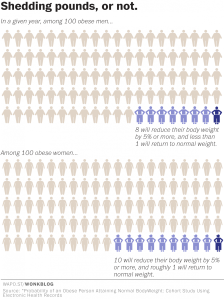I’ve been working on a longer post, which is taking more time than I though it would. Since I don’t want too much time to lapse between posts, I decided to take a break from working on that post to do something that I could put up relatively quickly.
When I’m losing weight, I seem to pay more attention to weight loss in the media. I’m more likely to watch programs like The Biggest Loser and Extreme Weight Loss when I’m losing weight. And I think I’m also much more likely to pay attention to news about diet and weight.
One such story grabbed my attention last week. I first heard about when it was briefly mentioned on the local morning news. Later that day, I saw a longer story in a daily news summary e-mail I receive from The Washington Post. That led me to read the full news story, and, ultimately, to track down the news release that prompted both stories.
The story was about a study conducted by researchers at King’s College London, which examined electronic medical records of nearly 300,000 people to determine weight loss trends. While the study had more than one conclusion about weight loss, the news stories picked up on one central finding: the chances of an obese person returning to a normal weight are extremely remote (1 in 210 for men, 1 in 124 for women).
The Washington Post story included this graphic, which I think really makes it clear how remote these chances are (click on the graphic to enlarge it):
 As someone whose weight still falls in the obese range, this headline caught my attention. In fact, on the surface, the news is pretty discouraging. One could read this as saying that I’m not likely to be successful.
As someone whose weight still falls in the obese range, this headline caught my attention. In fact, on the surface, the news is pretty discouraging. One could read this as saying that I’m not likely to be successful.
After examining the news release and the Washington Post story more closely, I decided the news didn’t have to be so depressing, for a couple of reasons.
First, the headlines were misleading. The headlines made it sound as if the lifetime chances were remote, but the statistics quoted (1 in 210 and 1 in 124) were annual chances. In other words, a man has a 1 in 210 chance of returning to a normal rate in any given year. But his lifetime chances would be much greater than that: over 30 years, his chances of returning to a normal weight would be roughly 30 in 210, or 1 in 7.* One chance in 7 is still not great, but it’s a lot more promising than 1 in 210.**
*I’m sure a statistician would say that it’s not quite as simple as multiplying 1/210 times 30, because there are issues involving “with or without replacement” and other factors, but I think the 30 in 210 calculation is still roughly accurate.
**Even 1 in 7 is the chance of returning to normal, but not necessarily remaining there. That’s a whole different challenge, which I’m sure I’ll revisit in a later blog entry.
Second, and perhaps more importantly, I’ve already beaten the odds, which encourages me that I might be able to beat these 1 in 210 odds. The study also examined the chances that an obese person lost 5 percent of his or her body weight in a given year. For men, those chances were 1 in 12, and for women, they were 1 in 10. I’ve done better than that: I have now lost more than 5% of my body weight four times in the last nine years. That gives me faith that I might be the exception to the rule, and that perhaps I’ll be the 1 in the 210 that reaches “normal.”
It’s easy to get discouraged. Losing weight is hard. But so is getting to the truth behind these studies, when one only looks at the headlines.